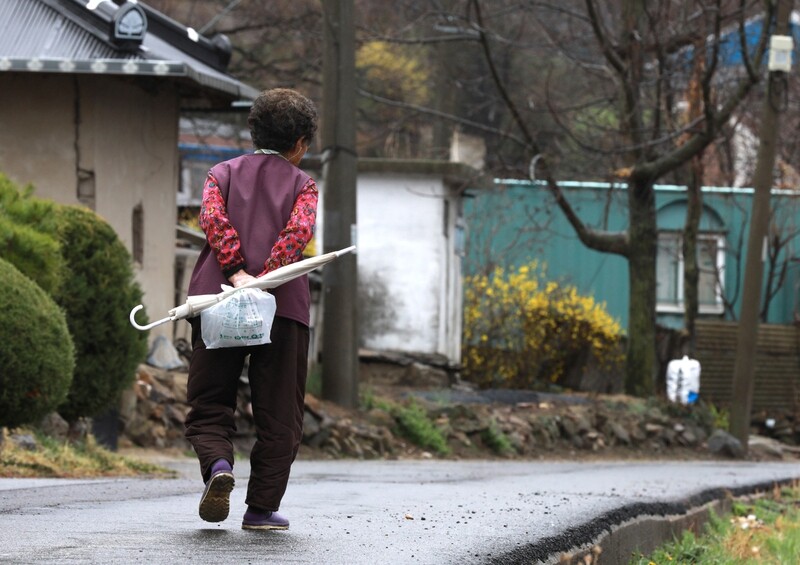hankyoreh
Links to other country sites 다른 나라 사이트 링크
S. Korean elderly comprise more than 40% of bottom 20% of income earners

A new analysis found that the elderly (70 years old and above) account for more than 40% of low income-earning householders (those that belong to the bottom 20% of income earners) in South Korea. The rapid aging of the population has pushed large numbers of elderly people out of the labor market and into the low income-earning group. In order to reduce the gap between income segments, many experts argue, the government must institute an income security system that’s tailored to the needs of elderly households.
On Oct. 9, Democratic Party lawmaker Kim Kyung-hup published an analysis of the current status of householders per income quintile based on data from Statistics Korea’s household trend survey (from 2003 to 2019). According to Kim’s analysis, elderly people represented 43.4% of the first quintile (the bottom 20% of income earners) as of the second quarter of 2019. That statistic, which covers households around the country, has increased by 29.7 points during the 16 years since 2003 (13.7%), when the government started tracking it. During the same period, the percentage of total households with an elderly householder rose 10.2 points, from 3.6% to 13.8%. In the fifth quintile (the top 20% of income earners), the percentage of elderly householders only increased by 2.2 points, from 0.4% to 2.6%. So while population aging has caused the number of elderly householders to increase, that increase has been concentrated in the low income-earning segment of the population.
The average number of employed persons per household in the bottom 20% of income earners declined by 0.1, from 0.78 in 2003 to 0.68 people in 2019. But in the top 20% of income earners, the number of employed persons rose by 0.28, from 1.82 to 2.1 people, over the same period. “Since population aging and the decrease in the working-age population are concentrated at the very bottom income bracket, we have an urgent need for the government to increase spending on strengthening the employment safety net and expanding jobs for the elderly, with a focus on the first quintile,” Kim said.
Along with population aging, elderly poverty is also affected by the breakdown of the family, including the growth in the number of single-person households.
“The percentage of elderly people who live with their children has greatly decreased during the process of industrialization, weakening distribution inside the family. The failure to establish a public system of support during the rapid unraveling of private support has contributed to the increase in elderly poverty and income inequality,” said Ku In-hoe, a professor of social welfare at Seoul National University in a paper titled “Policy Challenges and Adoption Strategies in the Area of Income Security” submitted to a public health and welfare forum this past May.
As ways of addressing elderly poverty, Ku suggested improving the basic living allowance system by eliminating a rule that bans elderly people with living family members from receiving the allowance. He also suggested strengthening government programs to provide income security during retirement by expanding the basic pension. Other policy ideas that are being discussed are providing greater tax exemptions or earned income tax credit for families that actually take care of an elderly person.
By Lee Kyung-mi, staff reporter
Please direct comments or questions to [english@hani.co.kr]

Editorial・opinion
![[Column] Samsung’s ‘lost decade’ and Lee Jae-yong’s mismatched chopsticks [Column] Samsung’s ‘lost decade’ and Lee Jae-yong’s mismatched chopsticks](https://flexible.img.hani.co.kr/flexible/normal/500/300/imgdb/original/2024/0512/3017154788490114.jpg) [Column] Samsung’s ‘lost decade’ and Lee Jae-yong’s mismatched chopsticks
[Column] Samsung’s ‘lost decade’ and Lee Jae-yong’s mismatched chopsticks![[Correspondent’s column] The real reason the US is worried about Chinese ‘overcapacity’ [Correspondent’s column] The real reason the US is worried about Chinese ‘overcapacity’](https://flexible.img.hani.co.kr/flexible/normal/500/300/imgdb/original/2024/0510/5217153290112576.jpg) [Correspondent’s column] The real reason the US is worried about Chinese ‘overcapacity’
[Correspondent’s column] The real reason the US is worried about Chinese ‘overcapacity’- [Editorial] Yoon’s gesture at communication only highlights his reluctance to change
- [Editorial] Perilous stakes of Trump’s rhetoric around US troop pullout from Korea
- [Guest essay] Preventing Korean Peninsula from becoming front line of new cold war
- [Column] The state is back — but is it in business?
- [Column] Life on our Trisolaris
- [Editorial] Penalties for airing allegations against Korea’s first lady endanger free press
- [Editorial] Yoon must halt procurement of SM-3 interceptor missiles
- [Guest essay] Maybe Korea’s rapid population decline is an opportunity, not a crisis
Most viewed articles
- 1Seoul’s plan to adopt SM-3 missiles is like wanting a sledgehammer to catch a fly
- 2[Column] Samsung’s ‘lost decade’ and Lee Jae-yong’s mismatched chopsticks
- 3[Correspondent’s column] The real reason the US is worried about Chinese ‘overcapacity’
- 4Korea poised to overtake Taiwan as world’s No. 2 chip producer by 2032
- 560% of young Koreans see no need to have kids after marriage
- 6[Editorial] Yoon’s gesture at communication only highlights his reluctance to change
- 7Yoon voices ‘trust’ in Japanese counterpart, says alliance with US won’t change
- 8Yoon rejects calls for special counsel probes into Marine’s death, first lady in long-awaited presse
- 9S.K.-Japan joint history project to be revived
- 10Former President Roh Tae-woo, mastermind of 1979 military coup, dies at 88